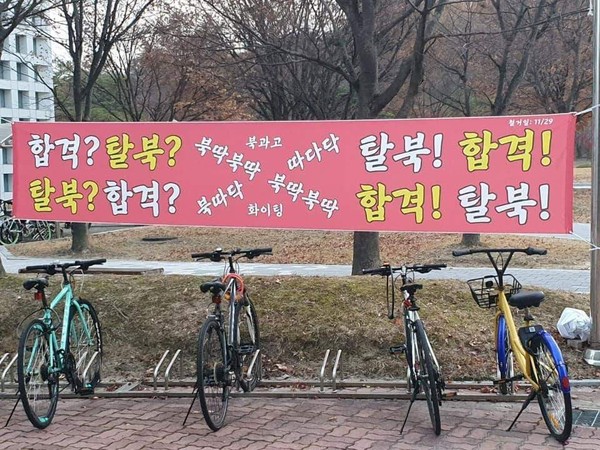KAIST student society was wrapped in controversy regarding a controversial term used on a banner that cheered on interviewees of the undergraduate admissions interviews. A post on KaDaeJeon on November 25 criticized the use of a term that originated from a notorious Korean right-wing populist website on one of the banners, and was followed by heated discussions and apologies.
During the undergraduate admissions interview period, student alumni of Korean high schools create and put up banners of encouragement around campus cheering on their underclassmen. Additionally, the content of the banners generally include various jokes or memes that are meant to be eye-catching and humorous.

Along these lines, alumni of Gyeonggibuk Science High School put up a banner that contained the Korean expression bukttadadak, in addition to the words talbuk and hapgyeok, meaning escaping from North Korea and [college] acceptance, respectively. However, one student recognized that the first term originates from the website Ilbe Storehouse and posted their concern on KaDaeJeon, questioning the suitability of publicly displaying such a word within school.
Ilbe Storehouse is an infamous Korean online community known for extremist and far-right views. Ilbe, shortened from Ilgan Best for “daily best”, evokes strong dislike from the general public, who view the site as hateful and dangerous. The word bukttadadak is used by Ilbe users to mock the late former South Korean president Roh Moo-hyun and his pro-North Korea stance.
Students flooded KaDaeJeon with different criticisms and opinions. Some defended the alumni, proposing that they could have been unaware of the word’s meaning, while others argued that the obscurity of the word implied certain previous knowledge. Some worried that the incident could reflect poorly on the university’s image.
On November 26, two members of the Gyeonggibuk Science High School alumni group uploaded separate apologies. The first was written by the leader of the class that had created the banner, explaining that the banner design was voted first place among four potential designs, and that it did not contain the controversial term during the initial voting process. However, during the feedback process, the term was inserted in order to “relieve [the interviewees’] tension” in line with chaotic humor, and the creators were unaware of the meaning behind it. The author of the post apologized for the lack of communication and research in making the banner, and the potential damage it may have brought to the school and the community. In addition, he expressed regret for the usage of the word talbuk for its carelessness, and delivered an apology to the North Korean escapees. The leader of the previous class also apologized for not monitoring the process closely, and asked students to “please stop baseless slander and spread of misinformation regarding the matter”.

